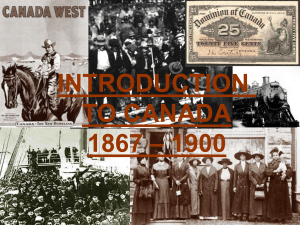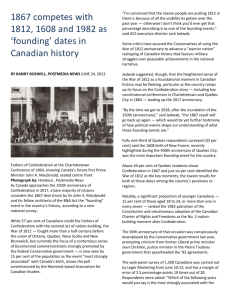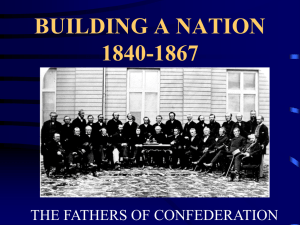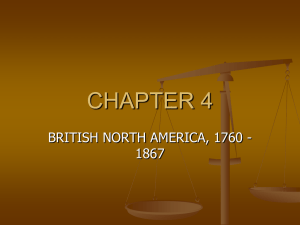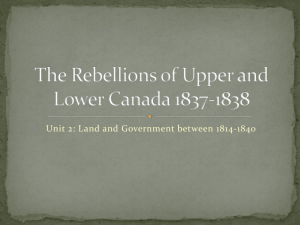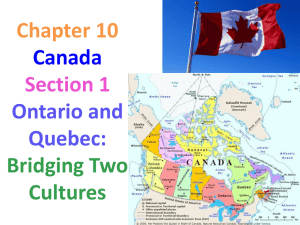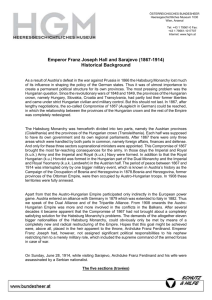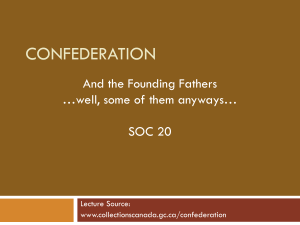19th Century Canada
advertisement
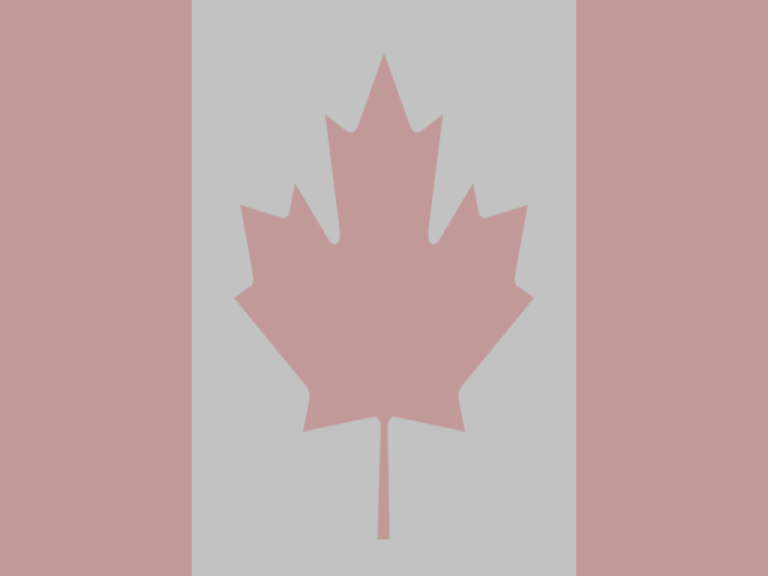
The Governor and Company of Adventurers of England trading into Hudson Bay The oldest corporation in North America, their royal charter in 1670 granted to them approx. 15% of all the land and control of the de facto government for the better part of a century. The Seven Years War 1756-63 The Treaty of Paris 1763 19th Century Canadian History At the end of the 18th century, France ceded much of Canada to Britain at the end of the Seven Years War in the Treaty of Paris 1763. After the War of 1812, Britain was relegated to approximately the modern Canadian-American border with only a few exceptions: 1. The Maine-New Brunswick border dispute erupted into the Aroostook War but was settled bloodlessly in 1842 with the Webster-Ashburton Treaty 2. The Dispute over the Oregon Territory was settled in the Oregon Treaty of 1846 The Battle of Lake Erie in the War of 1812 “We have met the enemy, and they are ours!” Cpt. Oliver Perry 19th Century Canadian History Following the War of 1812, tensions between Great Britain and the United States began to improve steadily over the remainder of the decade and a flood of European immigrants pour into the Americas, including Canada. 19th Century Canadian History In terms of governance, Britain had responded to the US Revolution by passing the Constitution Act of 1791, giving each colony the opportunity to elect a legislative assembly. The Rebellions of 1837 In 1834, the Legislative Assembly of Lower Cananda sent the “92 Resolutions” to Parliament. By 1837, British Colonial Secretary responds with his “10 Resolutions” (aka “Russell’s Resolutions”) They also pass additional anticolonial legislation The Rebellions of 1837 In November of 1837, insurrection broke out in Lower Canada (i.e. Quebec) against the British colonial government. Why? 1. The lack of representation 2. The Château Clique The Rebellions of 1837 Lord Durham, British Governor General The Durham Report 1839 1. Upper and Lower Canada should be united into one colony, called the Province of Canada, as this would help to unify the colony and assimilate the French Canadiens into Anglophone British culture. This happened in 1840, when the Act of Union was passed merging Upper and Lower Canada, but it failed to truly assimilate the French Canadians. 2. Grant the new united colony a “responsible government” (i.e. one in which the executive government is directly responsible and accountable to a directly elected parliament, rather than a monarch or imperial power) In 1848, the Province of Canada was granted a” responsible government”, but was frought with instability. The Canadian Confederation The new government was led by two men: one from each of the two regions, Canada East (Quebec) and Canada West (Ontario). Due to divisiveness, a coalition was formed in 1863 to unify the various factions: The Clear Grits – George Brown The Parti Bleu – George-Etienne Cartier Liberal-Conservatives – John MacDonald This led to the formation of the Canadian Confederation in 1867 under the condition that they resolve their constitutional issues by supporting a federal union of ALL British North American colonies. The British North America Act 1867 The Confederation immediately proceeded in reworking their constitution, specifically at the Charlottestown & Quebec Conferences. In 1867 they drafted the British North America Act (BNA) which: 1. Called the new country Canada 2. Renamed Canada East, Quebec, and Canada West, Ontario. 3. Designated itself a “Dominion” (from Ps. 72:8) Within days of its completion, it was quickly approved by both British Houses and agreed to by Queen Victoria. The British North America Act 1867 Having gone into effect on July 1, 1867 (Canada Day) the new confederated government outlined the following: 1. The union of the provinces 2. Balance of power 3. The judicial system 4. A bill of rights? The British North America Act 1867 “By adhering to the monarchical principle we avoid one defect inherent in the Constitution of the United States. By the election of the president by a majority and for a short period, he never is the sovereign and chief of the nation. He is never looked up to by the whole people as the head and front of the nation. He is at best but the successful leader of a party. This defect is all the greater on account of the practice of reelection. During his first term of office he is employed in taking steps to secure his own reelection, and for his party a continuance of power. We avoid this by adhering to the monarchical principle—the sovereign whom you respect and love. I believe that it is of the utmost importance to have that principle recognized so that we shall have a sovereign who is placed above the region of party—to whom all parties look up; who is not elevated by the action of one party nor depressed by the action of another; who is the common head and sovereign of all.” John A. MacDonald, 1st Prime Minister of Canada The British North America Act 1867 Unresolved Issues and Complications: 1. Provinces that did not want to be included (e.g. Nova Scotia) 2. No explicit bill of rights 3. Lack of full autonomy The British North America Act 1867 Effects: •Began the process that was to culminate in 1917 •Though not without some bloodshed, Canada achieved the independence that the U.S. wanted, though had to fight for.
